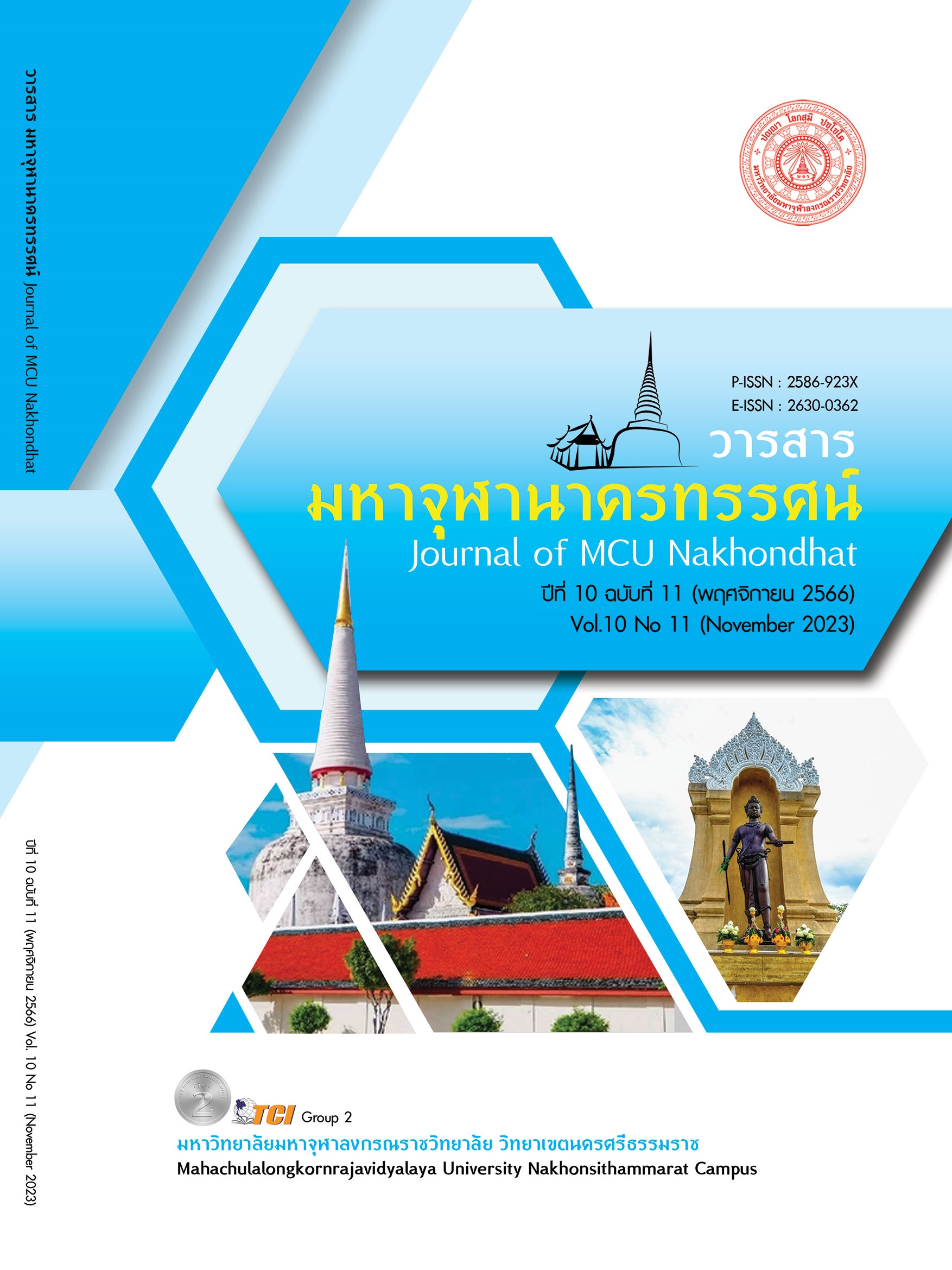DEVELOPMENT GUIDELINE FOR TOURISM POTENTIAL OF INTANGIBLE CULTURAL HERITAGE BASED ON STORIES AND MYTHS SUPPORTING EXPERIENTIAL TOURISM IN LANSAKA DISTRICT, NAKHON SI THAMMARAT PROVINCE
Main Article Content
Abstract
The objectives of this research were 1) to assess tourism potential of Intangible cultural heritage based on stories and myths supporting experiential tourism in Lanska District, Nakhon Si Thammarat Province and 2) to study the development guideline of tourism potential of Intangible cultural heritage based on stories and myths supporting experiential tourism. The methodology was mixed method. The tool of quantitative research was a potential assessment form collected random sample by purposive selection from representatives of government sector, private sector and academician were 9 samples. The quantitative data was analyzed by mean and standard deviation. The tool of qualitative research was focus group discussion collected random sample by purposive selection from representatives of local administrative organizations, government sectors, private sectors and academician were 15 samples. The quantitative data was analyzed by mean and standard deviation and the qualitative data was analyzed by content analysis and conclusion. The study found that the overall potential was at a low level ( = 2.56). The highest mean was stories and myths (
= 3.16), followed by places (
= 3.05), interpreters or sages
( = 2.54), activities (
= 2.15), and services and facilities (
= 2.19), respectively. The guidelines for potential development to support experiential tourism are the stories should be varied on attractive points and linked the various stories; the location should be improved the landscape to create an atmosphere and linked with other places; the activities should have various choices for different target tourists and invite tour operators to try activities; the local interpreters and sages should be elder persons and youth should encouraged making clip of recommendations via social media; and services and facilities should be taken various advantage in tourist centers such as waiting area for interpreters, folk playing area, product distribution shelf, ect., rotate the tourism volunteers and create unique experiential service.
Article Details

This work is licensed under a Creative Commons Attribution-NonCommercial-NoDerivatives 4.0 International License.
References
กรมการท่องเที่ยว. (2561). มาตรฐานการท่องเที่ยวโดยชุมชน. กรุงเทพมหานคร: โรงพิมพ์แห่งจุฬาลงกรณ์มหาวิทยาลัย.
กรมการท่องเที่ยว. (2566). กระแสนิยมการท่องเที่ยวปี 2566-2567. เอกสารประกอบการอบรมที่พักโฮมสเตย์และการท่องเที่ยวโดยชุมชนเชิงสร้างสรรค์เพื่อคนทั้งมวล. กรุงเทพมหานคร: กรมการท่องเที่ยว.
กระทรวงการท่องเที่ยวและกีฬา. (2565). แผนพัฒนาการท่องเที่ยวของไทยตามแผนพัฒนาการท่องเที่ยวแห่งชาติ ฉบับที่ 3 (พ.ศ. 2566-2570). กรุงเทพมหานคร: กระทรวงการท่องเที่ยวและกีฬา.
การท่องเที่ยวแห่งประเทศไทย สำนักงานนครศรีธรรมราช. (2566). แผนการตลาดการท่องเที่ยวจังหวัดนครศรีธรรมราชและจังหวัดพัทลุง พ.ศ. 2566. เรียกใช้เมื่อ 26 ตุลาคม 2566 จาก https://thainews. prd.go.th/th/news/detail/TCATG220213220330781
เขมิกา ธีรพงษ์. (2563). การพัฒนาการท่องเที่ยวเชิงวัฒนธรรมด้วยการออกแบบประสบการณ์. ศิลปกรรมสาร, 13(1), 1 - 15.
บุญเลิศ จิตตั้งวัฒนา. (2558). การพัฒนาการท่องเที่ยวแบบยั่งยืน. (พิมพ์ครั้งที่ 2). กรุงเทพมหานคร: ธรรมสาร.
ประภาพร ยางประยงค์ และศศิธร สุวรรณรัตน์. (2564). การศึกษาศักยภาพการท่องเที่ยวเชิงวัฒนธรรม: กรณีศึกษาย่านเมืองเก่า จังหวัดสงขลา. Journal of Social Sciences and Humanities Research in Asia, 27(3), 87 - 110.
ปุณยวีร์ ศรีรัตน์. (2564). การสร้างคุณค่าอาหารพื้นถิ่นสำหรับโปรแกรมการท่องเที่ยว อำเภอลานสกา จังหวัดนครศรีธรรมราช. วารสารวิจัยเพื่อการพัฒนาเชิงพื้นที่, 13(2) 106 - 110.
เพลินทิพย์ โกเมศโสภา. (2547). การวางแผนการตลาด (Marketing Planning). (พิมพ์ครั้งที่ 5). กรุงเทพมหานคร: โรงพิมพ์แห่งจุฬาลงกรณ์มหาวิทยาลัย.
ฟองจันทร์ หลวงจันทร์ดวง และคณะ. (2561). ศักยภาพชุมชนต้นแบบการท่องเที่ยวเชิงสร้างสรรค์อย่างยั่งยืน. วารสารอิเล็กทรอนิกส์การเรียนรู้ทางไกลเชิงนวัตกรรม, 8(2), 52-83.
ยุทธ ไกยวรรณ์ และกมลพรรณ ไกยวรรณ์. (2562). ระเบียบวิธีวิจัยทางด้านการโรงแรมและการท่องเที่ยว. กรุงเทพมหานคร: โรงพิมพ์แห่งจุฬาลงกรณ์มหาวิทยาลัย.
วิเชียร มันแหล่ และคณะ . (2564). รายงานวิจัยการท่องเที่ยวโดยชุมชนเชิงสร้างสรรค์บนฐานการเรียนรู้ภูมิปัญญาอาหารพื้นถิ่นชุมชนในอำเภอลานสกา จังหวัดนครศรีธรรมราช. นครศรีธรรมราช: สำนักงานคณะกรรมการวิจัยแห่งชาติ (วช.).
วิทัศน์ ศรีสุวรรณเกศ. (2561). แบบจำลองปัจจัยเชิงสาเหตุที่มีอิทธิพลต่อความภักดีของการท่องเที่ยวเชิงวัฒนธรรมล้านนาตะวันออก. ใน วิทยานิพนธ์บริหารธุรกิจดุษฎีบัณฑิต สาขาบริหารธุรกิจ. มหาวิทยาลัยเทคโนโลยีราชมงคลพระนคร.
ศูนย์วิจัยและสนับสนุนเป้าหมายการพัฒนาที่ยั่งยืน. (2565). SDG Move. เรียกใช้เมื่อ 26 ตุลาคม 2566 จาก https://www.sdgmove.com/intro-to-sdgs/
อารง สุทธาศาสน์ และวิภาส ทองสุทธิ์. (2563). ปฏิบัติการวิจัยสังคมศาสตร์ มาตรฐานวิทยานิพนธ์และดุษฎีนิพนธ์. กรุงเทพมหานคร: อินทภาษ.
entile, C. et al. (2007). How to sustain the customer experience : An overview of experience components that co-create value with the customer. European management journal, 25(5), 395 - 410.
Getz, D., & Page, S. J. (2016). Event studies : Theory, research and policy for planned events. Oxon: Routledge.
Kim, J. H. (2018). The impact of memorable tourism experiences on loyalty behaviors: The mediating effects of destination image and satisfaction. Journal of Travel Research, 57(7), 856 - 870.
Susan, R. et al. (2007). Online Customer Experience: A Review of the Business-to-Consumer Online Purchase Context. International Journal of Management Reviews, 13(2), 24 - 39.


